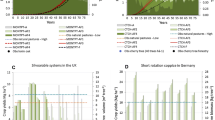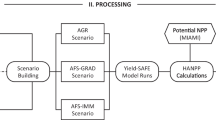Abstract
Agroforestry combines perennial woody elements (e.g. trees) with an agricultural understory (e.g. wheat, pasture) which can also potentially be used by a livestock component. In recent decades, modern agroforestry systems have been proposed at European level as land use alternatives for conventional agricultural systems. The potential range of benefits that modern agroforestry systems can provide includes farm product diversification (food and timber), soil and biodiversity conservation and carbon sequestration, both in woody biomass and the soil. Whilst typically these include benefits such as food and timber provision, potentially, there are benefits in the form of carbon sequestration, both in woody biomass and in the soil. Quantifying the effect of agroforestry systems on soil carbon is important because it is one means by which atmospheric carbon can be sequestered in order to reduce global warming. However, experimental systems that can combine the different alternative features of agroforestry systems are difficult to implement and long-term. For this reason, models are needed to explore these alternatives, in order to determine what benefits different combinations of trees and understory might provide in agroforestry systems. This paper describes the integration of the widely used soil carbon model RothC, a model simulating soil organic carbon turnover, into Yield-SAFE, a parameter sparse model to estimate aboveground biomass in agroforestry systems. The improvement of the Yield-SAFE model focused on the estimation of input plant material into soil (i.e. leaf fall and root mortality) while maintaining the original aspiration for a simple conceptualization of agroforestry modeling, but allowing to feed inputs to a soil carbon module based on RothC. Validation simulations show that the combined model gives predictions consistent with observed data for both SOC dynamics and tree leaf fall. Two case study systems are examined: a cork oak system in South Portugal and a poplar system in the UK, in current and future climate.



Similar content being viewed by others
Notes
DPM/RPM ratios are proposed in Coleman and Jenkinson (2014) for Agricultural crops and improved grasslands (1.44; 59% DPM and 41% is RPM), Unimproved grasslands and scrub (0.67; 40% DPM and 60% RPM); Deciduous or tropical woodland (0.25; 20% DPM and 80% RPM) and Farmyard manure (1; DPM 49%, RPM 49% and HUM 2%). When day of tree harvest occurs, the ratio between DMP and RPM is considered 0.25.
References
Bolinder MA, Angers DA, Dubuc JP (1997) Estimating shoot to root ratios and annual carbon inputs in soils for cereal crops. Agric Ecosyst Environ 63:61–66. doi:10.1016/S0167-8809(96)01121-8
Cardinael R, Chevallier T, Cambou A et al (2017) Increased soil organic carbon stocks under agroforestry: a survey of six different sites in France. Agric Ecosyst Environ 236:243–255. doi:10.1016/j.agee.2016.12.011
Caritat A, Bertoni G, Molinas M et al (1996) Litterfall and mineral return in two cork-oak forests in northeast Spain. Ann Des Sci For 53:1049–1058. doi:10.1051/forest:19960601
Christensen JH, Hewitson B, Busuioc A et al (2007) Regional climate projections. In: Solomon S, Qin D, Manning M et al (eds) Climate change 2007: the physical science basis contribution of working group I to the fourth assessment report of the intergovernmental panel on climate change. Cambridge University Press, Cambridge, pp 847–940
Coleman K, Jenkinson D (2014) RothC—a model for the turnover of carbon in soil—model description and users guide. Rothamsted Research, Harpenden
Cusack DF, Chou WW, Yang WH et al (2009) Controls on long-term root and leaf litter decomposition in neotropical forests. Glob Change Biol 15:1339–1355. doi:10.1111/j.1365-2486.2008.01781.x
den Herder M, Moreno G, Mosquera-losada R et al (2017) Current extent and stratification of agroforestry in the European Union. Agric Ecosyst Environ 241:121–132
Dziadowiec H, Jonczak J, Czarnecki A, Kacprowicz K (2008) Comparison of plant litter fall in two poplar plantations of Hybryda 275 and Robusta. Rocz Glebozn 59:76–83
Fagerholm N, Torralba M, Burgess PJ, Plieninger T (2016) A systematic map of ecosystem services assessments around European agroforestry. Ecol Indic 62:47–65
Ford A (1999) Modelling the environment. Andrew Ford Island Press, Washington
Francaviglia R, Coleman K, Whitmore AP et al (2012) Changes in soil organic carbon and climate change—application of the RothC model in agro-silvo-pastoral Mediterranean systems. Agric Syst 112:48–54. doi:10.1016/j.agsy.2012.07.001
Gan YT, Campbell CA, Janzen HH et al (2009) Root mass for oilseed and pulse crops: growth and distribution in the soil profile. Can J Plant Sci 89:883–893. doi:10.4141/CJPS08154
Gill H, Abrol I (1993) Afforestation and amelioration of salt-affected soils in India. In: Davidson N, Galloway R (eds) The productive use of saline land. Proceedings of a workshop held in Perth, Western Australia. ACIAR Proceedings No. 42. ACIAR, Perth, pp 23–27
Glover JD, Reganold JP, Cox CM (2012) Agriculture: plant perennials to save Africa’s soils. Nature 489:359–361. doi:10.1038/489359a
Gosme M, Dufour L, Inurreta-Aguirre H, Dupraz C (2016) Microclimate effect of agroforestry on diurnal temperature cycle. In: Gosme M (ed) 3rd European agroforestry conference—Montpellier, 23–25 May. Montpellier, pp 183–186
Graves AR, Burgess PJ, Palma JHN et al (2007) Development and application of bio-economic modelling to compare silvoarable, arable, and forestry systems in three European countries. Ecol Eng 29:434–449. doi:10.1016/j.ecoleng.2006.09.018
Hermle S, Anken T, Leifeld J, Weisskopf P (2008) The effect of the tillage system on soil organic carbon content under moist, cold-temperate conditions. Soil Tillage Res 98:94–105. doi:10.1016/j.still.2007.10.010
IPCC (2006) Guidelines for national greenhouse gas inventories, vol 4: agriculture, forestry and other land use. http://www.ipcc-nggip.iges.or.jp/public/2006gl/vol4.html. Accessed 15 Sept 2017
Lal R (2005) Soil carbon sequestration in natural and managed tropical forest ecosystems. J Sustain For 21:1–30. doi:10.1300/J091v21n01
Lorenz K, Lal R (2014) Soil organic carbon sequestration in agroforestry systems. A review. Agron Sustain Dev 34:443–454. doi:10.1007/s13593-014-0212-y
Madeira MV, Fabião A, Pereira JS et al (2002) Changes in carbon stocks in Eucalyptus globulus L. plantations induced by different water and nutrient availability. For Ecol Manag 171:75–85. doi:10.1016/S0378-1127(02)00462-0
Martin-Chave A, Mazzia C, Beral C, Capowiez Y (2016) How Agroforestry microclimates could affect the daily-activity of major predatory arthropods in organic vegetable crops? In: Gosme M (ed) 3rd European agroforestry conference—Montpellier, 23–25 May. Montpellier, pp 62–65
Montagnini F, Nair PKR (2004) Carbon sequestration: an underexploited envionmental benefit of agroforestry systems. Agrofor Ecosyst 61:281–295
Munns R, Schmidt S, Beveridge C (2016) Growth analysis: a quantitative approach. In: Munns R, Schmidt S, Beveridge C (eds) Plants in action, 2 edn. Australian Society of Plant Scientists, New Zealand Society of Plant Biologists, and New Zealand Institute of Agricultural and Horticultural Science
Oberholzer HR, Leifeld J, Mayer J (2014) Changes in soil carbon and crop yield over 60 years in the Zurich Organic Fertilization Experiment, following land-use change from grassland to cropland. J Plant Nutr Soil Sci 177:696–704. doi:10.1002/jpln.201300385
Palma J (2017) Resource communication: CliPick—climate change web picker. A tool bridging daily climate needs in process based modelling in forestry and agriculture. For Syst. doi:10.5424/fs/2017261-10251
Palma J, Graves A, Bunce R et al (2007) Modelling environmental benefits of silvoarable agroforestry in Europe. Agric Ecosyst Environ 119:320–334
Palma JN, Paulo J, Faias S et al (2015) Adaptive management and debarking schedule optimization of Quercus suber L. stands under climate change: case study in Chamusca, Portugal. Reg Environ Change. doi:10.1007/s10113-015-0818-x
Rao MR, Nair PKR, Ong CK (1998) Biophysical interactions in tropical agroforestry systems. Agrofor Syst 38:3–50. doi:10.1023/A:1005971525590
Schroeder P (1994) Carbon storage benefits of agroforestry systems. Agrofor Syst 27:89–97. doi:10.1007/BF00704837
Schroth G, Zech W (1995) Above- and below-ground biomass dynamics in a sole cropping and an alley cropping system with Gliricidia sepium in the semi-deciduous rainforest zone of West Africa. Agrofor Syst 31:181–198. doi:10.1007/BF00711725
Shanker AK, Newaj R, Rai P et al (2005) Microclimate modifications, growth and yield of intercrops under Hardwickia binata Roxb. based agroforestry system. Arch Agron Soil Sci 51:281–291. doi:10.1080/03650340500053407
Sloan VL, Fletcher BJ, Press MC et al (2013) Leaf and fine root carbon stocks and turnover are coupled across Arctic ecosystems. Glob Change Biol 19:3668–3676. doi:10.1111/gcb.12322
SOILSERVICE (2012) SOILSERVICE: Conflicting demands of land use, soil biodiversity and the sustainable delivery of ecosystem goods and services in Europe. Final publishable report
Thomas SC, Martin AR (2012) Carbon content of tree tissues: a synthesis. Forests 3:332–352
Upson M (2014) The carbon storage benefits of agroforestry and farm woodlands. PhD Thesis, Cranfield University. http://dspace.lib.cranfield.ac.uk/handle/1826/9298. Accessed 15 Sept 2017
van der Werf W, Keesman K, Burgess P et al (2007) Yield-SAFE: a parameter-sparse, process-based dynamic model for predicting resource capture, growth, and production in agroforestry systems. Ecol Eng 29:419–433. doi:10.1016/j.ecoleng.2006.09.017
Funding
European Commission through the AGFORWARD FP7 research Project (contract 613520), Forest Research Center strategic Project (PEst OE/AGR/UI0239/2014), the Portuguese Foundation for Science and Technology (FCT) fellowships SFRH/BD/52691/2014 and SFRH/BPD/96475/2013, XUNTA DE GALICIA, Consellería de Cultura, Educación e Ordenación Universitaria (“Programa de axudas á etapa posdoutoral”) (contract ED481B 2016/071-0)
Author information
Authors and Affiliations
Corresponding author
Electronic supplementary material
Below is the link to the electronic supplementary material.
Rights and permissions
About this article
Cite this article
Palma, J.H.N., Crous-Duran, J., Graves, A.R. et al. Integrating belowground carbon dynamics into Yield-SAFE, a parameter sparse agroforestry model. Agroforest Syst 92, 1047–1057 (2018). https://doi.org/10.1007/s10457-017-0123-4
Received:
Accepted:
Published:
Issue Date:
DOI: https://doi.org/10.1007/s10457-017-0123-4




